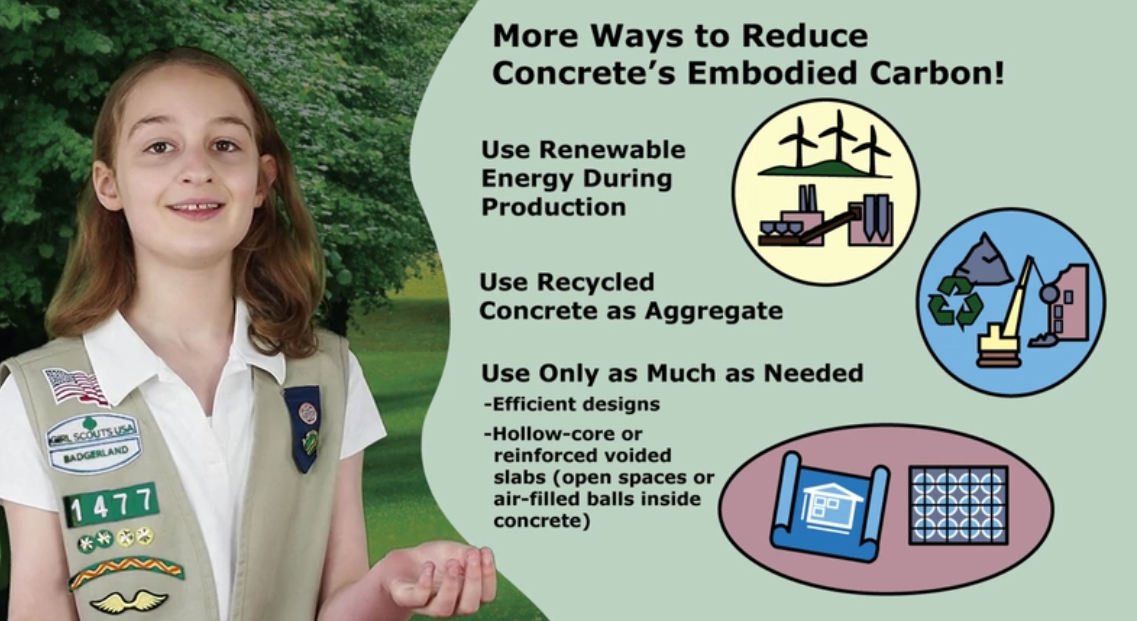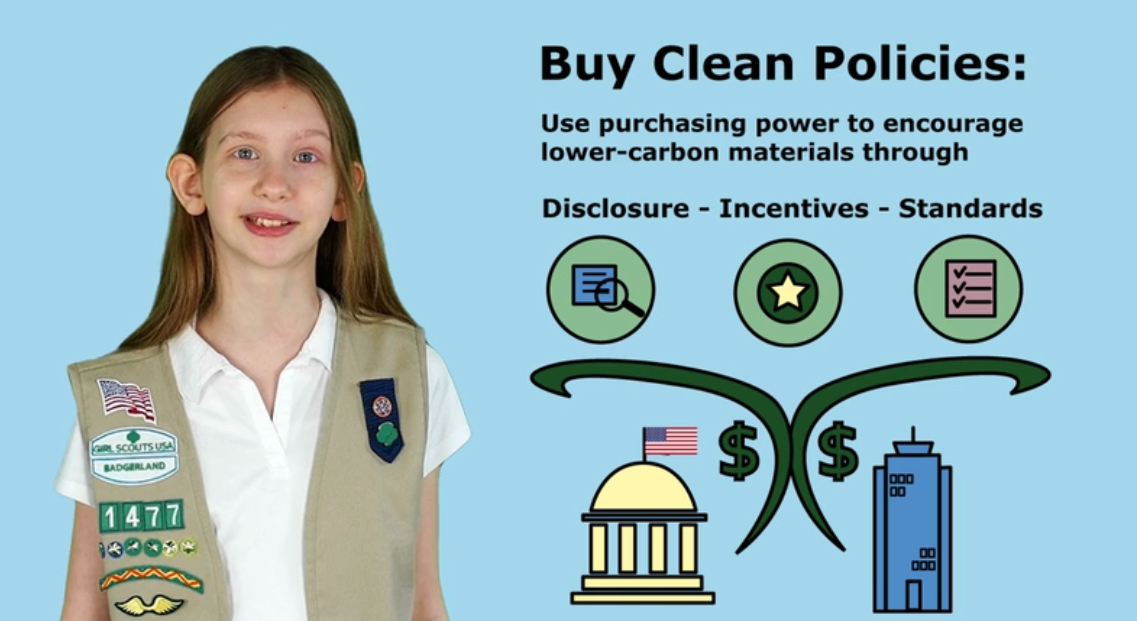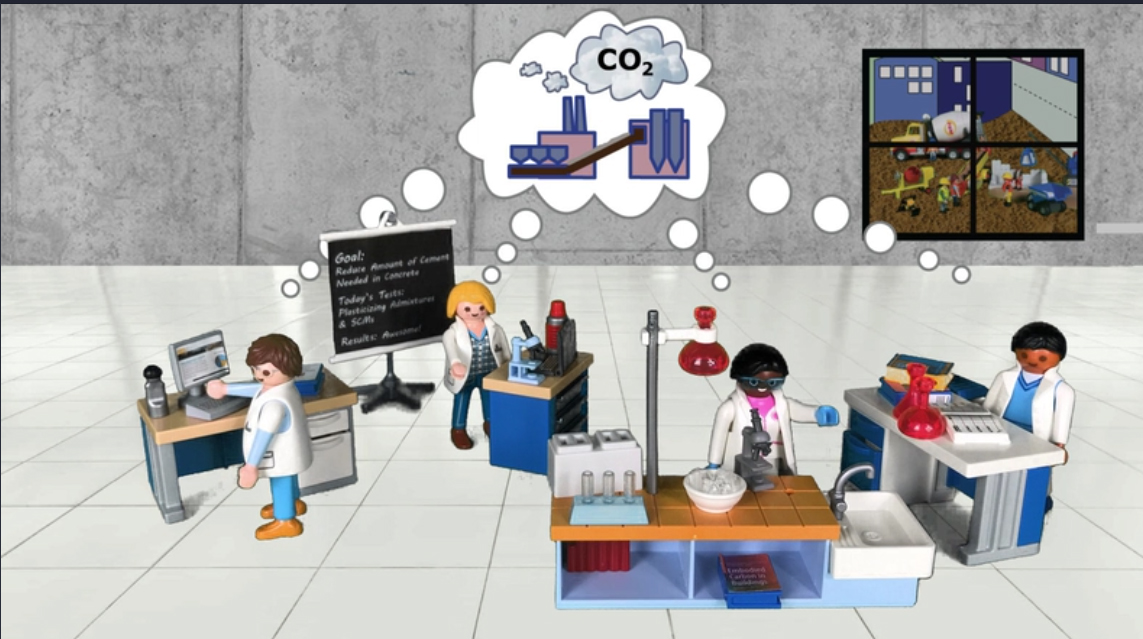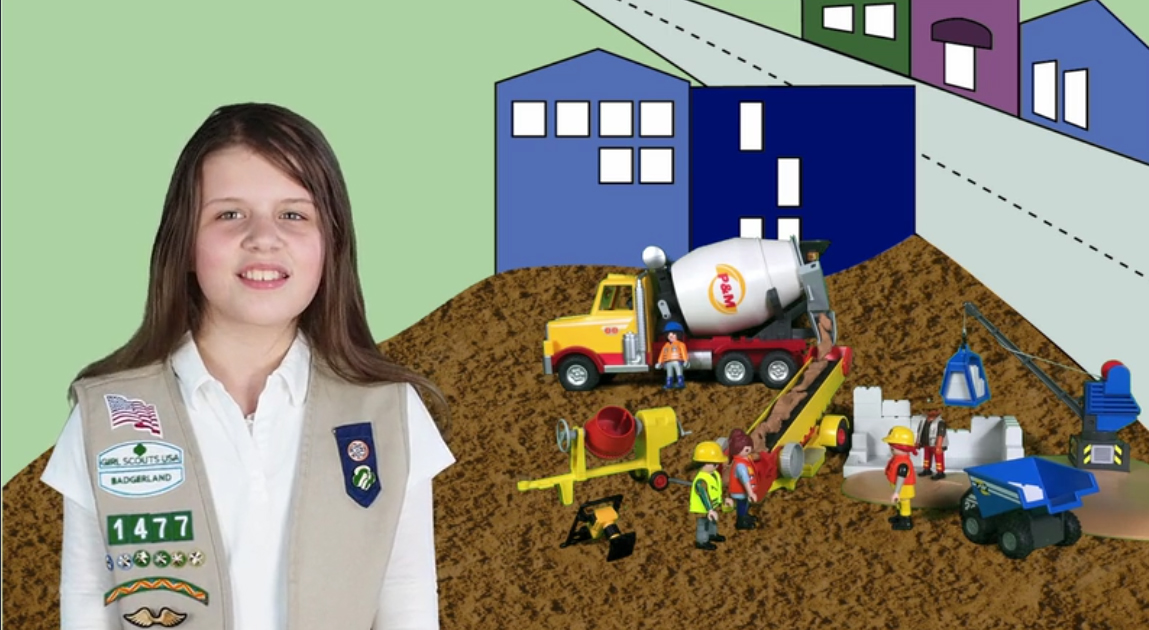Troops 1477 and 1952 Produce Educational Video on Embodied Carbon in Concrete
by Julia Pooler
Leader of Girl Scout Troop 1477 and 1952, Madison, Wisconsin, Badgerland Council
Girl Scout Troops 1477 and 1952 of the Wisconsin Badgerland Council decided they wanted to do a project to raise awareness about solutions to climate change. After looking into the biggest contributors to global warming, they were surprised to discover that embodied carbon of materials, especially concrete production, was a major factor. The Girl Scouts realized that among climate change topics, materials and concrete were less commonly discussed.
They also realized that as as Girl Scouts, they just might be able to reach a broader audience and have a material impact on a global challenge. The video they produced also turned out to be a wonderful opportunity for them to learn concepts in chemistry, engineering, architecture, planning, business, and policy, and to help them consider careers in these fields.
The troop reached out to a few local green building professionals, who confirmed that both embodied carbon and low-carbon concrete as topics were not yet regularly discussed in the local building industry. The troop also contacted several concrete professionals, including professionals from the National Ready Mix Concrete Association and the MIT Concrete Sustainability Hub, who described how the industry was actively working to get the word out about a range of lower carbon concrete options currently or soon available. The troop also learned that a general lack of awareness and demand was slowing the adoption of lower-carbon concrete, so they decided to make a video that could be easily shared, hoping a group of Girl Scouts could reach new audiences.

Ida Pooler explains the conceptual framework for understanding embodied carbon.
Concrete Climate Ideas: Girl Scouts Talk Building Materials & Embodied Carbon is a short film by Girl Scout Troop 1477 about embodied carbon and lower-carbon concrete. The film is targeted to architects, engineers, planners, developers, business leaders and policy makers involved in building decisions.
Our troop decided to do a project about concrete because we were interested in the topic of global warming. The fact that concrete is responsible for 8% of global carbon emissions helped us decide to help the cause. There are many ways to solve this, so it is important to think about how you can make concrete greener. I think it is important for everybody, especially kids, to care about embodied carbon and concrete because the more people know, the more people can help reduce CO2. — Everly Johnson, age 11
The girls started off their project by meeting virtually, learning basics about green building, how concrete is made, and some of the ways it can be made with lower embodied carbon through a variety of online educational resources. The girls also virtually attended the Global Concrete Summit in December of 2020, listening to online lectures and exploring virtual exhibits.

The Girl Scouts learned the essentials of story-telling, stop motion animation, and video production.
Before this project, I barely even knew that embodied carbon and concrete was an issue that people needed to think about. I think that’s the main problem we need to solve–we need people to know that this is a problem and spread the word. I hope that people in power can watch our video and help to create change. — Ava Sainsbury, age 11
Film Development
For the film, the girls decided to make the video to appeal to a broad spectrum of people involved in making planning and building decisions, including architecture, engineering, construction, and development firms, as well as public and private policy makers.

Kara King outlines some approaches for decarbonizing concrete

Everly Johnson explains the science behind concrete and CO2
I hope that people who are planning buildings will see our video and talk with architects and engineers. They can encourage them to think about their materials in terms of what they need them to do and be open to using lower carbon concrete. I hope we inspire them to look up more detailed information. Some of the greener options are just as good at doing the job and give off less CO2. — Kara King, age 11
The girls helped develop the video script, forming general outline and discussing points to include. They submitted drawings as concept art for backgrounds and story-board style scene illustrations. For Covid-19 safety, girls were filmed individually outside on a screen-porch turned green screen studio, tolerating Wisconsin-in-early-spring chills, wind, and (very) noisy birds to produce their individual recordings and arrange toy figurines for stop-motion animation sequences.

Willa Stedman carefully arranges a stop-motion animation scene
I hope that our climate change video will help the message of green building spread across the world. If we start using greener concrete more often, our world will have a healthier climate. — Basil N.
Next Steps
With the completion of the video, the girls plan to actively distribute the video by directly contacting leaders in the local building industry by email to notify them of the video and encouraging them to share it via their social media channels.

Evelyn Hennricks advocates the use of purchasing power to encourage low-carbon materials.
My section of the video was about EPDs- Environmental Product Declarations. Since these are kind of like nutrition facts for materials, I helped make a scene like a grocery store, except for concrete, so they are “shopping around” for lower carbon concrete. It was really fun arranging the scene and moving the little people. — Juniper Liberatore, age 10
One thing the girls are considering is to make a connection with local planning and development groups, identify a specific upcoming local building project, and encourage the project stakeholders to collaborate in making embodied carbon a priority.

The scientists in this virtual world are busy coming up with new ideas to decarbonize concrete.
I wanted to be involved with the concrete project because when I grow up I want to be an architect. Architects need to know about concrete because it is one of the materials you need to make buildings. — Willa Stedman, age 7
Another option under discussion is to identify local businesses and public agencies that specify concrete and encourage them to adopt Buy Clean policies. The girls will decide together which approaches they are most interested in trying, and some girls may pursue specific initiatives in smaller groups or individually.
All the girls bring their different interests to the project and have identified different potential roles with the project. They are excited to join the global effort to make buildings more carbon conscious. Help them spread the word by passing along the video to your colleagues and friends!

Talia Hackel explores a construction site in search of carbon savings.
Watch the Girl Scout Troop’s new music video!
Girl Scouting encourages girls to explore, identify problems, find practical solutions, and make their ideas a reality. One of the best ways they can have impact as young people is by raising awareness about a topic. Embodied carbon and concrete are global issues with practical solutions awaiting greater public awareness for adoption. — Troop Leader Julia Pooler
